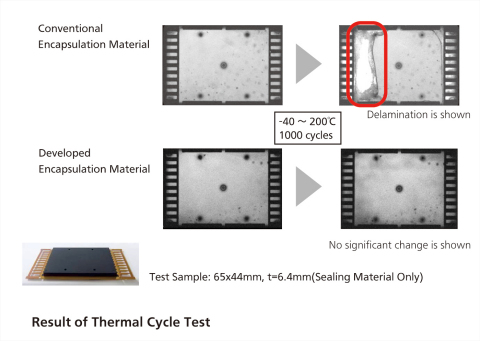OSAKA, Japan--(BUSINESS WIRE)--Panasonic Corporation today announced that it developed a semiconductor encapsulation material for power devices that boasts the industry's top-class*1 heat-resistance performance (glass transition temperature) of 210°C and superior long-term reliability, and will start shipping samples of the products, CV8540 series, from October 2015.
Requirements for vehicles that consume less energy and for smaller sized and lighter weight in-vehicle devices have been increasing. To address these issues, the industry is paying attention to power devices based on silicon carbide (SiC) or gallium nitride (GaN). When used in a vehicle, however, power devices must have superior high-temperature resistance and high-current characteristics, as well as excellent long-term reliability.
Silicon devices that are currently in wide use can sometimes reach temperatures of up to about 125 to 150°C when in operation. Because of their ability to deal with high current, SiC or GaN devices can operate in such high-temperature environments, even when temperatures soar to 200°C or more.
To make the most of this advantage, semiconductor encapsulation materials for power devices must also have greater advanced heat resistance and long-tern reliability. Conventional encapsulation materials are at a disadvantage in that they peel off from the leadframe and the device when subjected to high temperatures. Panasonic has now achieved the industry's top-class*1 heat-resistance performance and improved the adhesiveness inside the material, allowing the company to develop and commercialize a semiconductor encapsulation material with superior long-tern reliability.
This encapsulation material has the following advantages:
1. The industry's highest heat-resistance characteristics contribute to the use of power devices in a heat-generating or high-temperature environment.
High-temperature resistance characteristics (glass transition temperature of the encapsulation material): up to 210°C (our conventional products*2: 170 to 180°C)
2. Superior long-term reliability contributes to improving the reliability of power devices.
In the following environmental resistance tests, neither cracks in the encapsulation material nor peeling from the leadframe and the power device element were observed.
• Thermal cycle test: -40 to 200°C, 1,000 cycles
• High-temperature shelf test: Left at 200°C for 3,000 hours
*1 As a semicondoctor encapsulation material for SiC or GaN power devices. Internal investigation as of October 1, 2015
*2 Our conventional product (CV4100 series)
|
Characteristics |
||||||
| Item | Unit | Development material | ||||
| For copper frame packages | For ceramic substrate packages | |||||
| Glass transition temperature (Tg) | °C | 210 | ||||
| Coefficient of thermal expansion | ppm/°C | 14 | 11 | |||
| Flexural strength | MPa | 110 | 100 | |||
| Flexural modulus | GPa | 13 | 13 | |||
| Coefficient of moisture absorption | % | 0.3 | 0.3 | |||
| Mold shrinkage | % | 0.15 | 0.1 | |||
| Molding method | Transfer molding, Compression molding | |||||
|
*All values above are typical representations and not guaranteed values. |
||||||
About Panasonic
Panasonic Corporation is a worldwide leader in the development of diverse electronics technologies and solutions for customers in the consumer electronics, housing, automotive, enterprise solutions and device industries. Since its founding in 1918, the company has expanded globally and now operates 468 subsidiaries and 94 associated companies worldwide, recording consolidated net sales of 7.715 trillion yen for the year ended March 31, 2015. Committed to pursuing new value through innovation across divisional lines, the company uses its technologies to create a better life and a better world for its customers. To learn more about Panasonic: http://www.panasonic.com/global.






.jpg)